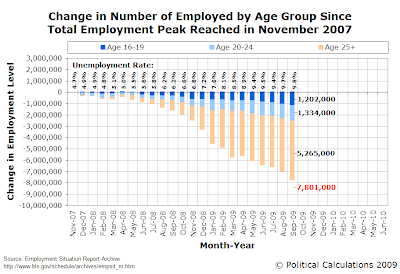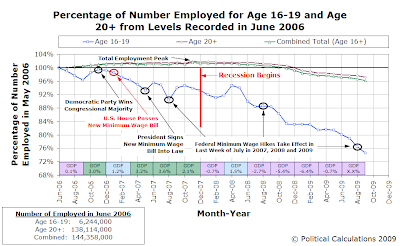

By contrast, looking at the overall level of employment, we find that total employment in the United States has been reduced by 1 in 25 jobs, or by roughly 4% below the level recorded in June 2006.
As we've previously demonstrated, the increases in the federal minimum wage are responsible for all teen job loss in 2007 and 88% of all teen job loss through 2008. A recent study confirms much of our previous analysis:
Despite the $1.2 billion in stimulus money the Congress set aside for summer jobs for youth, the summer youth employment rate hit a record low of 29.1 percent - the lowest since World War II, according to a new study that concluded still more federal spending is needed.
The author of the study, Northeastern University labor economist Andy Sum, had predicted shortly after the Recovery Act was passed that employment for 16- to 19-year-olds for June and July would be 32.1 percent.
Now, Sum says, without further federal action, things are not expected to get better anytime soon.
"Given the likely absence of any near term resurgence in [overall] employment growth, teens will face declining employment rates through 2010 in the absence of new and expanded job creation strategies targeted upon teens and young adults (20-24)," states the study, titled Nation's Teen Summer Employment Rate Hits New Post-World War II Low: Effects of Federal Jobs Stimulus Overwhelmed by Private Sector Job Decline.
The study determined that the length and severity of the 2007-2009 recession were to blame for the record low youth employment this summer, and the fact that more adults were willing to compete with teens for a wide array of entry level positions. It also found that rising federal and state minimum wages "appear to have influenced employers to scale back the hiring of teens, especially those with limited work experience, and rely instead on more experienced workers."
Meanwhile, lobbyists are advocating for relief from the federal government:
Jonathan Larsen, policy associate at the Washington, D.C.- based National Youth Employment Coalition, said there will be a need for federal action even when the economy turns around.
"The only alternative at this point, because we don't expect any recovery in employment rates for teens and young adults, is to have some kind of federally funded employment program," Larsen said. "If we want young people to have work experience, we need to invest federal money."
As might be expected, the proposals being floated about for consideration fall far short of addressing the real causes of the teen job loss crisis, as they "target" certain favored political constituencies rather than the larger problem affecting far more people. That larger problem is the result of a minimum wage set far too high with respect to the level of wages needed to maximize total employment levels in today's economy, which is contributing to the overall shortage of job opportunities for teens and young adults, who disproportionately make up the number of people who earn these low wages:
To improve the youth employment situation, Sum recommends the creation of a national task force on youth employment and several other measures, including:
- An immediate increase of up to $5 billion in federal spending to create both year-round and summer jobs for teens and young adults under the Workforce Investment Act.
- The use of federal funds to hire year-round Career Specialists in each local WIA service delivery area to help develop year-round and summer paid internships for youth in the private sector.
- The creation of tax credits for employers who expand the number of workers on their payrolls and the testing of wage subsidies for private sector employers hiring youth from high poverty neighborhoods. Both the tax credits and wage subsidies should resemble similar initiatives from the 1970s, namely, the New Jobs Tax Credit and Youth Entitlement demonstrations, respectively, the study stated.
The 1970s would be the last time the federal minimum wage was set far too high. The tax credits and wage subsidies mentioned above were largely ineffective in addressing high teen unemployment rates. Instead, it took the sustained corrosive effects of inflation without additional minimum wage increases to erode the excessive mandated minimum wage level back to where employers would be willing to hire unskilled teens. Given today's deflationary expectations coursing through the economy, that approach is not a viable option for a speedy recovery in teen employment levels.
At least Sum recognizes the consequences of not correcting the situation:
"In the absence of any comprehensive new set of strategies to dramatically boost teen employment, the labor market for teens will continue to deteriorate over the next few years with adverse consequences for their future employability and earnings," the study stated.
Indeed. If only the politicians currently running the show in Washington, the lobbyists seeking favors for special interests at the expense of the whole public interest and the authors of studies that fail to fully account for the causes of the teen employment crisis cared more. Even a little.
Labels: jobs, minimum wage
Welcome to the blogosphere's toolchest! Here, unlike other blogs dedicated to analyzing current events, we create easy-to-use, simple tools to do the math related to them so you can get in on the action too! If you would like to learn more about these tools, or if you would like to contribute ideas to develop for this blog, please e-mail us at:
ironman at politicalcalculations
Thanks in advance!
Closing values for previous trading day.
This site is primarily powered by:
CSS Validation
RSS Site Feed
JavaScript
The tools on this site are built using JavaScript. If you would like to learn more, one of the best free resources on the web is available at W3Schools.com.